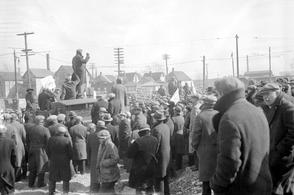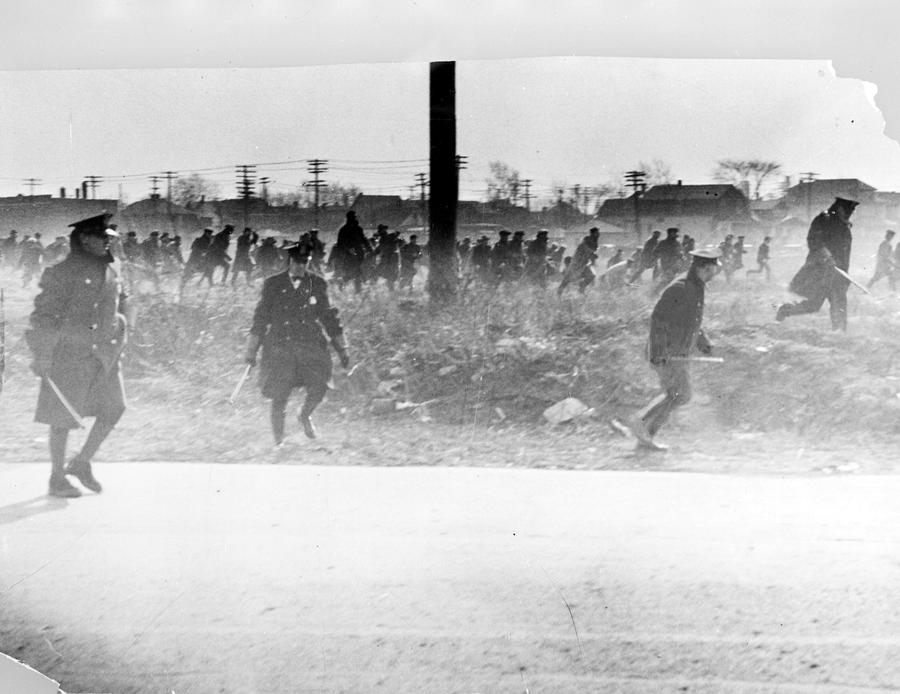After hearing Lincoln’s Emancipation Proclamation and conscription orders, white Detroiters used the trial of William Faulkner as a catalyst to destroy property within black neighborhoods. Two were killed, hundreds injured.
The riot was one of many riots across the country in response to the Enrollment Act of Conscription. Similar to the riot in New York, the Detroit riot was in response to race and class tension surrounding the issues of slavery, draft exemption, and employment. The Detroit Free Press is accused of inciting resentment against African Americans.
The riot resulted in the creation of a full-time police force for Detroit.
Sources :
Detroit Draft Riot, courtesy of the Charles H. Wright Museum of African American History. Ironically, the two girls recanted their testimony and seven years later William Faulkner was releasted from prison. 3:24 minutes.
LOCAL INTELLIGENCE.: TRIAL OF THE NEGRO FAULKNER. Detroit Free Press, March 6, 1863, p. 1 Courtesy of Proquest Historical Newspapers.
LOCAL INTELLIGENCE.: TRIAL OF THE NEGRO FAULKNER. Conclusion of the Case and Arguments for the Defense. The Jury Immediately Return a Verdit of “Guilty.” HE IS SENTENCED TO THE STATE PRISON FOR LIFE. INTENSE EXCITMENT. Detroit Free Press, March 7, 1863, p. 1 Courtesy of Proquest Historical Newspapers.
A BLOODY RIOT.: The Provost Guard Fire Upon a Defenseless Crowd. ONE MAN KILLED AND MANY WOUNDED. Assault upon a Negro Hovel and Murder of the Inmates. A BLOOD-THIRSTY AND UNMANAGEABLE MOB. The City Fired in Twenty Places. THE MILITARY OUT TO SUPPRESS THE RIOT. The Twenty-Seventh Regiment Summoned ffom Ypsilanti. Patrol Guards Established Throughout the city. THE GREATEST EXCITEMENT EVER KNOWN IN DETROIT. Detroit Free Press, March 7, 1863, p. 1 Courtesy of Proquest Historical Newspapers.
THE GREAT RIOT.: Thirty-five Buildings Destroyed. NO NEGROES KILLED. The Wounded Rapidly Recovering. Outside Reports and Street Rumors Greatly Exaggerated. EFFICIENT SERVICE OF THE FIRE DEPARTMENT. A Large Police Force Guarding the City. PROCLAMATION OF THE MAYOR. Detroit Free Press, March 8, 1863, p. 1 Courtesy of Proquest Historical Newspapers.
Steve Neavling, “Today in history: White mobs attacked blacks during Detroit race riot of 1863“, Motor City Muckracker, March 6, 2017.
Michigan: A History of the Wolverine State by Willis Frederick Dunbar.
Historical Society of Michigan Michigan History Calendar
Detroit Race Riot of 1863 wikipedia entry
Matthew Kundinger, Racial Rhetoric: The Detroit Free Press and Its Part in the Detroit Race Riot of 1863, Michigan Journal of History.
But wait, wasn’t there a race riot in Detroit back in 1833? See June 17, 1833 : Thorton Blackbird and his Wife Lucie, Runaway Slaves, Rescued by Detroit African Americans
On this evening 150 ladies and gentlemen at the Detroit Club listened to a live concert in Chicago via telephone. Elisha Grey, electrician from the Western Telegraphic Manufacturing Company of Chicago, arranged the demonstration. The previous longest transmission was 84 miles. The one at the Detroit Club covered a distance of 284 miles.
“Musical Lightning”, Detroit Free Press, March 7, 1877, column 6.

On March 6, 1896, 10 years after Carl Benz patented the first gasoline-powered automobile in Germany, and three years after the Duryea Brothers’ first vehicle, Charles King became the first driver of a gasoline automobile in Detroit.
Three months before Ford took the wheel, King had his own momentous first drive, a spin that began when he steered his vehicle down St. Antoine Street to Jefferson Avenue, and then swung north on Detroit’s famous Woodward Avenue to Grand Boulevard. After that, he turned around and headed home, only to be greeted by a police officer who threatened to ticket him for disturbing the peace.
The drive was accomplished in full view of hundreds of spectators who were thrilled with what they were seeing.
Residents woke up to the Detroit Free Press story: “The first horseless carriage seen in this city was out on the streets last night … It is the invention of Charles B. King, a Detroiter, and its progress up Woodward Avenue about 11 o’clock caused a deal of comment, people crowding around it so that its progress was impeded. The apparatus seemed to work all right, and went at the rate of 5 or 6 miles an hour at an even rate of speed.”
“I am convinced,” King told the Detroit Journal, “that, in time, the horseless carriage will supercede the horse.”
Born in California in the mid-1860s to a father who was an Army general in the Civil War Union, King received his training in mechanical engineering from Cornell University in Ithaca, N.Y. He had a million ideas of what to do with his life.
King moved to Detroit in 1889 at age 21, but it was only after a visit to the Chicago Exposition in 1893 that he realized a way to channel his ideas.
There, he spotted Gottlieb Daimler’s self-propelled carriage. If you could imagine after hundreds of years of horse-drawn wagons, there was suddenly no horse.
King set about to build a horseless carriage of his own and upon learning that New England’s Duryea Brothers, Charles and Frank, had already built and tested an automobile, there was no time to waste.
King served as a mentor to Henry Ford, Ransom Olds, Jonathan Maxwell, Henry Joy and others. In fact, he provided parts, instructed and assisted Henry Ford on his first quadricycle at the same time King developed his own car.
In 1903, King became chief engineer of the Northern Motor Car Co., where he designed the two-cylinder “Silent Northern” automobile that featured numerous innovations and the first running boards.
On the 1907 Northern model, he designed air brakes, an air-controlled clutch and other innovations for which he was granted patents. He was wildly successful, but boredom was starting to show.
Five years later, King left the company and spent two years in Europe studying automotive design. He returned to Detroit in 1910 and launched the King Motor Car Co. The King “Eight” (V-8) was billed as “The Car of No Regrets.”
In fact, at the New York Auto Show in 1912, the King automobile was the only one to feature left-hand steering, which soon became the industry standard. At that time, he already had more than 40 automotive patents to his credit.
That year, however, he left his company, devoting his time to working on numerous other experiments and inventions.
Sources :
Steven Rieve, Charles B. King pioneered horseless carriages, Las Vegas Review-Journal, February 27, 2009.
More trivia from 1896
Librarians must have sensed they were on to something when they bought the Detroit Public Library’s (DPL) first automotive book in 1896. That was the same year that inventor Charles Brady King took his gas-powered automobile on its maiden voyage on the streets of Detroit, beating out Henry Ford by three months.
From then on, the library’s automotive stockpile accelerated to the point that the National Automotive History Collection (NAHC) was created in 1953. It’s the world’s largest public automotive archive.
Originally housed on the fourth floor of the Main Library, the non-circulating NAHC has been on the second floor of the Skillman branch in downtown Detroit since 2003.
For more information, see “Tracking Car Culture”, Hour Detroit, January 2011.
William Clinton spoke to the state legislature becoming only the second sitting U.S. President to address Michigan’s lawmakers. Theodore Roosevelt was the first in 1907.
Source : Historical Society of Michigan
Lidstrom, a Swede nicknamed the Perfect Human, retired in 2012 after a 20-year career during which he won four Stanley Cups and seven Norris Trophies, including one in his penultimate season at age 41.
“When (general manager) Ken Holland told me that Mr. (Mike) and Mrs. (Marian) Ilitch wanted to retire my jersey, I tried to put the honor in context,” Lidstrom told a sold-out Joe Louis Arena crowd Thursday night before the Red Wings lost to the Avalanche, 3-2 in overtime. “It’s not like winning a trophy for a successful season or a playoff. It’s not like winning an individual trophy. This is something different.
“This is about being a Detroit Red Wing.”
The Red Wings also made the playoffs every year Lidstrom played.
“Simply the best,” Holland said during the hour-long ceremony that pushed the game back to 8:30 p.m.
Described as a humble role model by those who know him, Lidstrom becomes just the seventh Red Wings player to have his number retired and the first defenseman. The other numbers in the rafters are Steve Yzerman’s 19, Terry Sawchuk’s 1, Alex Delvecchio’s 10, Ted Lindsay’s 7, Sid Abel’s 12 and Gordie Howe’s 9.
Lidstrom finished his career second among Red Wings in games played (1,564), first in plus/minus (450), third in assists (878) and fourth in points (1,142).
For the full article, see Josh Katzenstein, “Red Wings honor Nicklas Lidstrom, ‘simply the best'”, Detroit News, March 6, 2014.
After more than 5 hours of discussion, at 1 a.m. on Tuesday morning, March 6, 2108, the Kalamazoo City Commission voted 5-1 to relocate the Fountain of the Pioneers from its most-prized park and develop a plan for putting something new in its place. It was the culmination of recent activism — though public debate has persisted since the monument was established.
The controversial monument pits a Native American in headdress head-to-head with a westward-facing settler. This charged imagery sustained a long debate about what Alfonso Iannelli intended to convey since the fountain was finished in 1940.
Some felt the monument celebrates the violent removal of indigenous peoples from Kalamazoo, making the park a hostile and unwelcoming place. It’s symbolic of the survival of white supremacist ideology, members of the Pokagon Band of Potawatomi Indians said.
Existing symbols of forced removal cause daily pain to indigenous people, said Seth Allard. The veteran is a member of the Sault Ste. Marie Tribe of Chippewa Indians, and is also known as “Man Who Walks The Red Road.”
For the full article, see Malachi Barrett, “Kalamazoo votes to remove controversial Bronson Park fountain“, MLive, March 6, 2018.
Malachi Barrett, “Controversial Bronson Park fountain recommended for removal“, MLive, March 1, 2018.
Malachi Barrett, “Should it stay? 26 opinions on Kalamazoo’s controversial fountain“, MLive, November 21, 2017.
Malachi Barrett, “Public debates meaning of fountain in Kalamazoo’s Bronson Park”, MLive, November 20, 2017.
Background and Status Report : Fountain of the Pioneers Bronson Park Master Plan (Bronson Park 21st Century Capital Campaign), November 20, 2017.

On March 7, 1932, the Ford Hunger March was organized by John Schmies, communist candidate for mayor of Detroit, and led by Albert Goetz. 3,000 marched from Detroit to Dearborn asking for union recognition, full employment (Ford had undergone massive layoffs) and a 6-hour work day with no reduction in wages. When Dearborn police attempted to stop them at the border, rioting resulted, killing 4 marchers and injuring around 60. A fifth participant later died as well.

Tear gas fills the air as Dearborn Police and Ford Motor Company Servicemen attack demonstrators outside of the Rouge Plant during the 1932 Ford Hunger March. Photo courtesy of the Walter P. Reuther Library.
The press vilified the Hunger Marchers as communist radicals. But Henry Ford was already unpopular among some middle class workers. Despite news reports, popular opinion was on the side of those who participated in the Hunger March.
After the Hunger March, Ford employees were forbidden to even talk to each other before starting work and during lunch breaks at the Ford plant.
Within a few days of the Hunger March, Ford discharged thousands of workers. If there was any suspicion that a worker was even sympathetic to the Hunger Marchers’ cause, they were let go.
If you’re on the shop floor in 1935, and you start speaking about labor organizing, you were escorted out,” Mike Smith, Archivist for the Michigan Historical Collections at the University of Michigan’s Bentley Historical Library, says. “In fact, Henry Ford was the last of the Big Three to organize. Ironically, he gave the UAW its best contract, because if he was going to let a union organize, he didn’t want to be outdone by GM or Chrysler.”
Sources :
Detroit Historical Society Facebook Page
“CuriosiD: What was the 1932 Ford Hunger March?“, WDET, August 10, 2015.
“4 Die in Riot at Ford Plant; Murder Charges Asked After Red Mob Fights Police”, Detroit Free Press, March 8, 1932, front page.
John Lippert, “Hard Times ’32: A Hunger March”, Detroit Free Press, March 7, 1982, p. 13.
Larger and larger lake freighters were carrying the ore vital to the war effort, and it was determined that a new, longer and deeper lock had to be built to replace the now obsolete Weitzel Lock. The St. Mary’s River had been dredged during the 1930s to 24 feet, but the Poe and Sabin Locks, which handled most of the traffic on the American side, couldn’t accommodate boats drawing more than 20 feet.
Congress ordered construction of a new lock on March 7, 1942, to replace the old Weitzel with one that would handle the new breed of freighters. The new lock would be named after Douglas MacArthur, the war hero of the Pacific theater. Previously, the Weitzel and Poe Locks had taken eight years to build; the Davis Lock, six. But this was wartime, and the new lock had to be built ASAP.
Work began on September 1, 1942, as the initial cement forms were laid. Crews of the Great Lakes Dredge and Dock Company worked around the clock. When temperatures plunged below zero during the frigid winter months, heaters had to be employed to allow the cement to set. Work on the MacArthur Lock was completed in a mere 16 months, and dedication ceremonies were held on July 11, 1943. The first boat through the new lock was the Carl D. Bradley. The contractor and its workers received the Army–Navy E Award for their efforts in building the crucial new lock in record time. The estimated 1,000-plus construction workers added to the housing burden that already had tiny Sault Ste. Marie bursting with soldiers.
Source:
Rachel North, “Northern Michigan History: When the Soo Locks Readied for World War II“, UpNorth, February 18, 2014.
On March 7, 1972, East Lansing, Michigan became the first city in the country to ban discrimination on the basis of sexual orientation in regards to city hiring. The city of East Lansing has also prohibited discrimination based on sexual orientation in housing and public accomodations or services in addition to employment, according to city code. Still fighting for inclusiveness, the city council voted in January 2012 to support a lawsuit pushed by the American Civil Liberties Union against the state of Michigan, which passed a law prohibiting public employers from offering benefits to domestic partners, including gay and lesbian couples.
Source : Beau Hayhoe, “E. L. celbrates anniversary banning LGBT discrimination”, State News, March 12, 2012.
In 2019, the Michigan Library & Historical Center will celebrate its 30th year. The dedication took place on Tuesday, March 7, 1989.
At a cost of 42 million dollars, it combined the museum, state library, and archives all under one roof. Previously, all three were scattered throughout the area.
Governor James Blanchard cut the symbolic ribbon and announced, “Now we have the envy of the nation”.
Located at 702 W. Kalamazoo Street in downtown Lansing, it still proudly stands, holding many of Michigan’s treasured history within.
Source: John Robinson, “Michigan Library & Historical Center’s 30th Anniversary“, 99.1 WFMK Blog. February 12, 2019.
